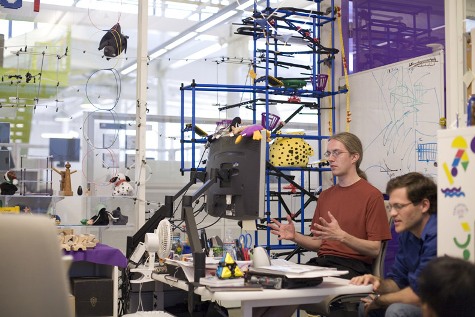 |
| http://ctboom.com/wp-content/uploads/00-Google-Work-Environment.jpg |
The Google workplace,
located in New York, has used research to create the perfect place for
creativity to thrive. One Google
spokesman, Jordan Newman, stated that “Google’s various offices and campuses
around the globe reflect the company’s overarching philosophy, which is nothing
less than ‘to create the happiest, most productive workplace in the world’” (as
cited in Stewart, 2013, para. 5). The
article tells about all of the steps taken by Google in order to facilitate
creativity in its workers. There are
many interesting features in the Google workplace, such as a hallway of Pac-man
machines, ladders between floors, and programs meant to assist in helping the
workers relieve stress (Stewart, 2013).
There is a big incentive for Google to facilitate creativity, because
“Google’s success depends on innovation and collaboration” (Stewart, 2013,
para.14). If creativity is not fostered,
then the company may not do as well. One
thing that helps especially is that the software engineers “design their own
desks or work stations out of what resemble oversize Tinker Toys” (Stewart,
2013, para. 8). This stimulates their
creativity and personalizes their workspace.
When one enjoys a job, it is much easier, and enjoyable, to do well and
commit time to it (Stewart, 2013).
 |
| http://www.astroman.com.pl/img/magazyn/596/o/Google_accent_engatwork.jpg |
Creative cognition is a technique developed by Ronald
Finke which “trains people to think creatively” (Goldstein, 2011, p. 350). One exercise called creative building,
modeled after one designed by Finke, shows this concept. In the exercise, the participant picks three
shapes randomly, and has to combine them into one figure. However, it cannot be simply one random
figure. The participant is given a
category, and they have to create a figure which would fit into the given
category. The participant must think
creatively about the random shapes they chose, the category given, and how the
shapes could be combined into a useful, relevant, object (Goldstein,
2011). Once one has begun to think
creatively, it becomes much easier. When
a company, such as Google, is based upon creativity, it is in their best interest
to make the environment as conducive to creativity as possible. Applying Finke’s creative cognition technique
helps make the environment more conducive to creativity.
Google has taken research and applied it to the workplace
in order to stimulate and encourage creativity in its workers (Stewart, 2013). It is designed to help foster the creativity
already present in the workers and increase productivity. This helped me understand the concept of
creative cognition more, because of the real-life application. Having the engineers build their own office
spaces out of objects similar to Tinker Toys, shows me that this process of
creative building does work (Stewart, 2013).
Their framework, or category, to follow, was that of an office
space. Then, they took the Tinker Toys
and built an office space (Stewart, 2013).
While Google has used lots of different research to help make their
workplace happier and more productive, one used is creative cognition. It has helped me understand the concept more,
and Google is a very successful company, with happy, productive, creative
workers (Stewart, 2013).
References
Goldstein, E. B.
(2011). Cognitive psychology: Connecting mind, research, and everyday
experience (3rd ed.). Canada: Wadsworth, Cengage Learning.
Stewart, J. B.
(2013, March 15). Looking for a lesson
in Google’s perks. The New York Times. Retrieved
from http://www.nytimes.com/2013/03/16/business/at-google-a-place-to-work-and-play.html?_r=2&adxnnl=1&pagewanted=all&adxnnlx=1363792467-yPvSgFWWUpYXmaLGv47ZIg&
No comments:
Post a Comment